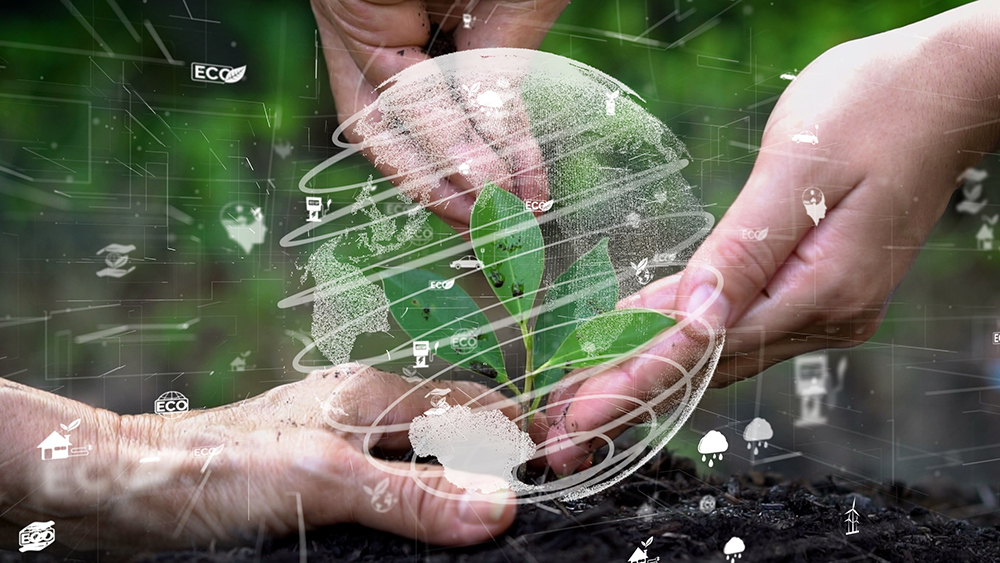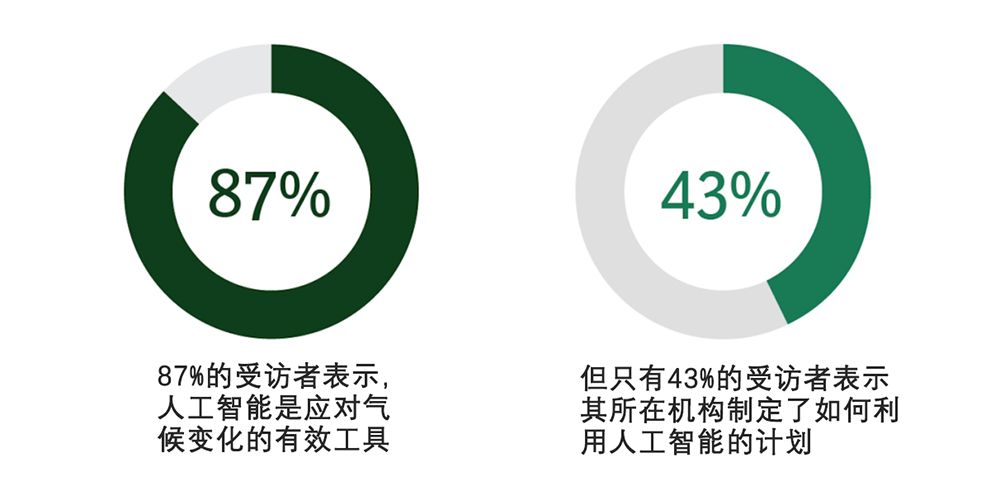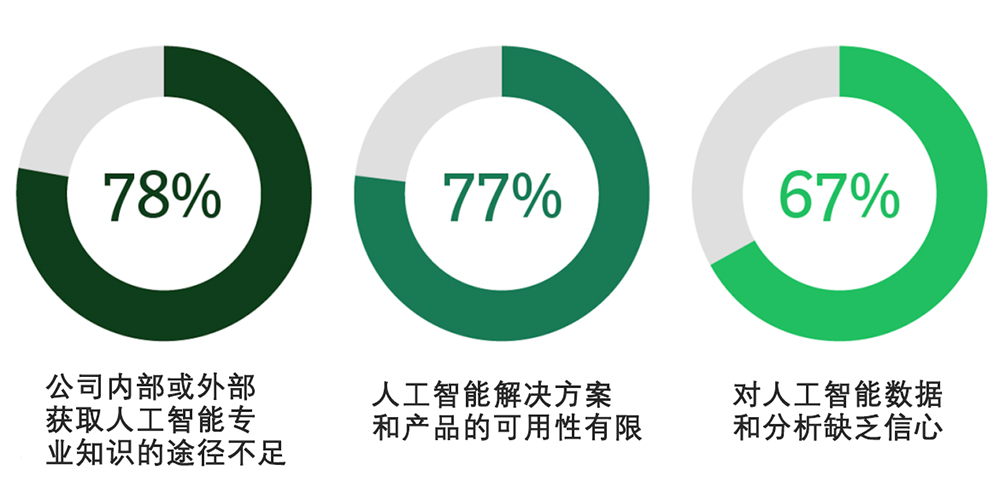如何利用人工智能应对气候变化?

在你的公司,每天或许会做出数百个决策,可能提高或降低公司的可持续性。我们应该选择哪一家供应商?我们的产品应该采购绿色玻璃还是透明玻璃?我们应该在伦敦还是纽约举办会议?
人工智能能够帮助企业完善决策,从而优化财务业绩、改进流程、满足客户需求等。它对于企业实现气候目标同样关键。事实上,人工智能可以收集、整理和解读庞大复杂的碳排放和气候影响数据集,因此它对于管理全部气候相关问题至关重要。
波士顿咨询公司(BCG)最近对全球1,000位人工智能和气候领域的领导者进行了调查,向我们展现了人工智能在这方面的潜力,以及在应用人工智能过程中所面临的障碍。我们发现,有87%的受访者感觉高级分析和人工智能或者单纯的“人工智能”,是目前应对气候变化的有效工具,但只有43%的受访者表示计划利用人工智能帮助公司应对气候变化。

他们认为人工智能在减少和测算排放方面具有最大的商业价值。事实上,全球领导者能够通过各种方式利用人工智能实现他们的气候目标:
减排。人工智能可以帮助测算宏观和微观层面的排放,减少排放的影响,并从大气中清除现有排放。我们在工作中发现,人工智能能够将一家企业的碳足迹减少5%至10%,如果扩大到全球,减少的温室气体排放量就相当于26亿吨至53亿吨二氧化碳当量。
有一些令人激动的例子可以证明人工智能已经在这方面发挥作用。由阿尔·戈尔投资的气候跟踪(跟踪实时大气碳排放)(Climate TRACE)联盟利用卫星图像和人工智能测算排放量。其成员Blue Sky Analytics能够专门估算火灾产生的排放量。Pachama利用卫星图像和人工智能测算和监控森林碳汇的变化,以此确定高质量碳信用额度。
波士顿咨询公司的二氧化碳人工智能平台可以帮助大规模测算、模拟、跟踪和优化机构的碳排放。这款可即时部署的软件能够在所有工业部门广泛应用,包括石油天然气、生物制药、汽车和消费品等领域。它不仅可以准确测算公司自营业务的直接排放量(范围一和范围二排放),还能够测算公司整个价值链产生的更难测算的间接排放(范围三排放)。
适应性和气候应变能力。人工智能还适合帮助预测气候相关危害,包括改善对局部事件的长期预测,比如海平面上升等,或者更新对飓风或干旱等极端现象的预警系统。例如,东南亚地区的一个项目就展示了人工智能和高级分析如何帮助当地社区适应气候变化。该项目团队将卫星数据与高级洪水模拟相结合,可以识别医院等关键基础设施以及最容易暴发洪水的湿地等,从而了解在哪些战略位置安放人工屏障能够发挥最大效果。
人工智能也可以帮助管理漏洞和风险,监控当前危机,强化基础设施(比如通过智能灌溉),通过预测大规模迁徙模式保护人类,以及通过识别和统计物种数量保护生物多样性等。
研究、金融和教育。人工智能还能够作为支持气候研究和模拟的有效工具,帮助了解气候变化的规模,并为政策决策提供参考。人工智能可以预测碳价格,在气候金融方面发挥着关键作用。人工智能还能够通过个性化的工具帮助教育公众,影响行为,例如预测个人碳足迹,或者推荐购买气候友好的商品等。无论是减排还是适应气候变化,或者提升气候应变能力,投资这些人工智能驱动的基础领域将是成功的关键。
克服人工智能应用的障碍
既然强大的人工智能有这么多机会在应对气候变化方面发挥作用,到底是什么让企业迟迟不愿意扩大人工智能的应用范围呢?在有些领域,人工智能解决方案已经非常成熟,可以进行广泛应用,但大多数现有解决方案不成体系,可能难以获得,并且缺少扩大规模的资源。有78%的受访者表示,应用人工智能的障碍源于没有充分的人工智能专业知识,77%的受访者提到了有限可用性,而有67%的受访者则是由于对人工智能相关数据和分析缺乏信心。

人工智能并非万能灵药。它只是我们用来应对气候变化这项全球挑战的诸多工具之一。但它能够帮助我们选择一条更明智、日益以数据驱动的和更快速的道路,而且我们没有时间可以浪费。(财富中文网)
本文作者克里斯托夫·施伟策(Christoph Schweizer)现任波士顿咨询公司全球首席执行官。波士顿咨询公司是《财富》杂志“零排放路径”(Path to Zero)项目的合作伙伴。
译者:刘进龙
审校:汪皓
在你的公司,每天或许会做出数百个决策,可能提高或降低公司的可持续性。我们应该选择哪一家供应商?我们的产品应该采购绿色玻璃还是透明玻璃?我们应该在伦敦还是纽约举办会议?
人工智能能够帮助企业完善决策,从而优化财务业绩、改进流程、满足客户需求等。它对于企业实现气候目标同样关键。事实上,人工智能可以收集、整理和解读庞大复杂的碳排放和气候影响数据集,因此它对于管理全部气候相关问题至关重要。
波士顿咨询公司(BCG)最近对全球1,000位人工智能和气候领域的领导者进行了调查,向我们展现了人工智能在这方面的潜力,以及在应用人工智能过程中所面临的障碍。我们发现,有87%的受访者感觉高级分析和人工智能或者单纯的“人工智能”,是目前应对气候变化的有效工具,但只有43%的受访者表示计划利用人工智能帮助公司应对气候变化。
他们认为人工智能在减少和测算排放方面具有最大的商业价值。事实上,全球领导者能够通过各种方式利用人工智能实现他们的气候目标:
减排。人工智能可以帮助测算宏观和微观层面的排放,减少排放的影响,并从大气中清除现有排放。我们在工作中发现,人工智能能够将一家企业的碳足迹减少5%至10%,如果扩大到全球,减少的温室气体排放量就相当于26亿吨至53亿吨二氧化碳当量。
有一些令人激动的例子可以证明人工智能已经在这方面发挥作用。由阿尔·戈尔投资的气候跟踪(跟踪实时大气碳排放)(Climate TRACE)联盟利用卫星图像和人工智能测算排放量。其成员Blue Sky Analytics能够专门估算火灾产生的排放量。Pachama利用卫星图像和人工智能测算和监控森林碳汇的变化,以此确定高质量碳信用额度。
波士顿咨询公司的二氧化碳人工智能平台可以帮助大规模测算、模拟、跟踪和优化机构的碳排放。这款可即时部署的软件能够在所有工业部门广泛应用,包括石油天然气、生物制药、汽车和消费品等领域。它不仅可以准确测算公司自营业务的直接排放量(范围一和范围二排放),还能够测算公司整个价值链产生的更难测算的间接排放(范围三排放)。
适应性和气候应变能力。人工智能还适合帮助预测气候相关危害,包括改善对局部事件的长期预测,比如海平面上升等,或者更新对飓风或干旱等极端现象的预警系统。例如,东南亚地区的一个项目就展示了人工智能和高级分析如何帮助当地社区适应气候变化。该项目团队将卫星数据与高级洪水模拟相结合,可以识别医院等关键基础设施以及最容易暴发洪水的湿地等,从而了解在哪些战略位置安放人工屏障能够发挥最大效果。
人工智能也可以帮助管理漏洞和风险,监控当前危机,强化基础设施(比如通过智能灌溉),通过预测大规模迁徙模式保护人类,以及通过识别和统计物种数量保护生物多样性等。
研究、金融和教育。人工智能还能够作为支持气候研究和模拟的有效工具,帮助了解气候变化的规模,并为政策决策提供参考。人工智能可以预测碳价格,在气候金融方面发挥着关键作用。人工智能还能够通过个性化的工具帮助教育公众,影响行为,例如预测个人碳足迹,或者推荐购买气候友好的商品等。无论是减排还是适应气候变化,或者提升气候应变能力,投资这些人工智能驱动的基础领域将是成功的关键。
克服人工智能应用的障碍
既然强大的人工智能有这么多机会在应对气候变化方面发挥作用,到底是什么让企业迟迟不愿意扩大人工智能的应用范围呢?在有些领域,人工智能解决方案已经非常成熟,可以进行广泛应用,但大多数现有解决方案不成体系,可能难以获得,并且缺少扩大规模的资源。有78%的受访者表示,应用人工智能的障碍源于没有充分的人工智能专业知识,77%的受访者提到了有限可用性,而有67%的受访者则是由于对人工智能相关数据和分析缺乏信心。
人工智能并非万能灵药。它只是我们用来应对气候变化这项全球挑战的诸多工具之一。但它能够帮助我们选择一条更明智、日益以数据驱动的和更快速的道路,而且我们没有时间可以浪费。(财富中文网)
本文作者克里斯托夫·施伟策(Christoph Schweizer)现任波士顿咨询公司全球首席执行官。波士顿咨询公司是《财富》杂志“零排放路径”(Path to Zero)项目的合作伙伴。
译者:刘进龙
审校:汪皓
Every day, people throughout your organization make decisions—possibly hundreds of them—that either increase or decrease its sustainability. Which supplier should we choose? Do we procure green glass or clear glass for our product? Should we host the conference in London or New York?
Just as artificial intelligence has improved the decisions organizations make to optimize financial performance, improve processes, meet customer needs, and more, it will be critical in helping them reach their climate goals. In fact, because it can gather, complete, and interpret large, complex datasets on emissions and climate impact, A.I. is fundamentally important in helping to manage the full range of climate-related issues.
BCG recently conducted a global survey of 1,000 leaders in A.I. and climate that tells us more about that potential—as well as the barriers getting in the way. We found that 87% of respondents feel that advanced analytics and A.I., or simply “A.I.,” is a helpful tool in the fight against climate change today, but only 43% say that they have a vision for using A.I. in their own climate change efforts.
They see the greatest business value for AI in the reduction and measurement of emissions. In fact, there are many diverse ways in which global leaders can use A.I. to achieve their goals:
Mitigation. A.I. can help measure emissions at the macro and micro levels, reduce the effects of emissions, and remove existing emissions from the atmosphere. In our work, we’ve found that A.I. can help reduce GHG emissions equal to 5% to 10% of an organization’s carbon footprint, or 2.6 to 5.3 gigatons of CO2e if scaled globally.
There are some exciting examples of technology already doing this work. Climate TRACE (Tracking Real-Time Atmospheric Carbon Emissions), a coalition backed by Al Gore, uses satellite imagery and A.I. to measure emissions. Blue Sky Analytics, a member of Climate TRACE, can estimates emissions specifically from fires. And Pachama uses satellite imagery and A.I. to measure and monitor the carbon stored in forests over time, identifying high-quality carbon credits.
BCG’s CO2 A.I. platform helps organizations measure, simulate, track, and optimize their emissions at scale. This ready-to-deploy software can be used across all industries, including oil and gas, biopharmaceuticals, automotive, and consumer products. It not only accurately measures emissions directly produced by the company’s own activities (Scopes 1 and 2) but also quantifies the more difficult-to-measure, indirect emissions produced along the company’s entire value chain (Scope 3).
Adaptation and resilience. A.I. is also well suited to help anticipate climate-related hazards, whether by improving long-term projections of localized events, such as sea-level rise, or by upgrading early warning systems for extreme phenomena, such as hurricanes or droughts. One such example of how A.I. and advanced analytics can help communities adapt to changing climates is a program in Southeast Asia. By combining satellite data with advanced flood modeling, the team there was able to identify critical infrastructure such as hospitals, as well as the wetlands most at risk of flooding, and understand where strategically placed artificial barriers could do the most good.
AI can also help with vulnerability and exposure management, monitoring current crises, strengthening infrastructure (through smart irrigation, for example), protecting populations by predicting large-scale migration patterns, and preserving biodiversity, such as by identifying and counting species.
Research, finance, and education. A.I. can also be an instrumental tool in supporting climate research and modeling, to understand the scale of change and inform policy decisions. It can play a critical role in climate finance, by forecasting carbon prices. And A.I. can help educate the public and influence behavior, through personalized tools that can estimate carbon footprints, for example, or make recommendations for climate-friendly purchases. Investing in these A.I.-powered fundamentals will be key to the success of both mitigation and adaptation and resilience efforts.
Overcoming A.I.’s roadblocks
With so many powerful opportunities for A.I. to make a difference in this struggle, what’s holding organizations back from putting it to greater use? While there are already areas in which A.I. solutions are well established and ready for broad application, most existing solutions are scattered, can be inaccessible, and lack the resources to scale. Among survey respondents, 78% say the roadblocks are due to insufficient AI expertise, 77% cite limited availability, and 67% point to a lack of confidence in A.I.-related data and analysis.
A.I. is not a cure-all. It’s one of many tools we should be using to address this global challenge. But it can help us go down a more informed, increasingly data-driven, and faster path—and we have no time to lose.
Christoph Schweizer is the Global CEO of Boston Consulting Group. Boston Consulting Group is a partner of Fortune’s Path to Zero.













